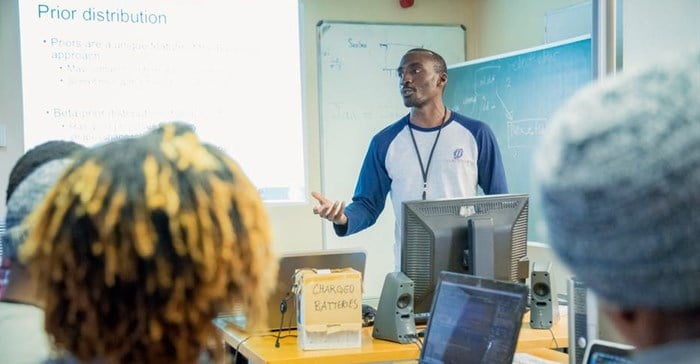
This kind of modelling is a complex, multidisciplinary field that has flourished over the past 15 to 20 years. But most work has been done by researchers based in Europe and North America – far away from the places where infectious diseases pose the biggest threat. This mismatch can lead to imbalances in the focus of research. For example, published papers may focus more on topics of academic interest or popular appeal than on pressing local health issues.
Models have enormous potential to improve how decisions are made about public health in African countries. For example, they have been used to address important questions such as how to evaluate new vaccines and how climate change will affect disease vectors. Models can also incorporate economic costs and be used to inform decisions about investing in public health.
Learning to address such questions is difficult. Students must develop a deep understanding of health issues as well as sophisticated mathematical skills. They must also learn to communicate about their work to policy makers and the public.
Worldwide, the main approach to developing these skills follows the traditional model of postgraduate education. New researchers learn from long-term association with those who have done key work in the field before them.
There are two problems with this approach. First, it is a slow way to transfer skills, with each expert only able to supervise a few students at a time. Second, it is a very localised process: it builds expertise only where it can already be found.
Meanwhile, diseases such as Ebola, measles and yellow fever continue to spread in areas of the world that lack the expertise to integrate models and data in a way that is useful to inform policy decisions. This means it is necessary to develop local capacity in these methods.
The traditional approach to capacity development for mathematical modelling, including epidemiological modelling, involves bringing small groups of specialists from developed countries to teach short courses to groups of African students. These typically last for no more than a week and are usually one-off events, or are repeated with new groups of students.
That approach can be useful for imparting technical skills. But it’s not enough to build local capacity. This is because technical skills are not embedded in a broader context of how to approach applied, interdisciplinary research – including working with collaborators trained in different disciplines and communicating results to policy makers.
On top of this, the short-term nature of the interactions means that mentoring and instructional skills development are not emphasised.
Alternative ways of working have been developed. For the past 10 years workshops run under the International Clinics in Infectious Disease Dynamics programme have helped develop capacity in applied epidemiological modelling on the continent.
We have built workshops – referred to as clinics – that are very hands-on. These are focused explicitly on communication and on contextualising models within public health questions. At the same time, they are aimed at developing key technical skills.
They also differ from typical workshops by integrating participants from around the world. But, importantly, all clinics have African faculty members who develop and present material. The aim is to make these workshops a true international endeavour, rather than a one-way transfer of knowledge.
Another emphasis has been on helping African participants build networks across geographic and disciplinary borders. Participants come from a wide range of backgrounds, including mathematics, statistics, public health, and epidemiology. And we have created a pipeline that allows some strong participants to eventually develop into workshop faculty.
The programme has two core components. These emphasise the use of data to inform the construction of clear and concise models appropriate to answer a given question.
Meaningful modelling: the annual Clinic on Meaningful Modeling of Epidemiological Data exposes participants to a diverse set of modelling approaches that allow them to engage with real-world questions about infectious disease dynamics. Participants learn to integrate mathematical models with epidemiological data.
The clinic consists of two tracks. One targets quantitative scientists; the other, public health workers. In the second week participants collaborate on research projects, working in interdisciplinary groups. Six weeks after the clinic, they must submit group reports on their work. This gives them real-world experience working in international, interdisciplinary teams to produce a research product.
Health researchers and population biologists: Another annual clinic focuses on Dynamic Approaches to Infectious Disease Data. It targets public health researchers and population biologists studying infectious diseases.
Instruction focuses on identification of infectious disease research questions that can be usefully addressed using mechanistic models and construction of models tailored to these questions. Participants develop written research proposals for their systems of interest. They also receive guidance to seek out the resources they need for carrying out their proposed research.
Faculty members are from many fields and at different career stages. This ensures that participants have someone to engage with about their current work or future plans; enhances programme sustainability; and builds local capacity in both training and research. And innovative teaching and learning techniques developed for the Clinics have even been adapted for training students in other parts of the world.
Zinhle E. Mthombothi, a Junior Researcher at Sacema, and Faikah Bruce, a PhD candidate at University of Cape Town and Sacema, contributed to this article.
This article is republished from The Conversation under a Creative Commons license. Read the original article.![]()

The Conversation Africa is an independent source of news and views from the academic and research community. Its aim is to promote better understanding of current affairs and complex issues, and allow for a better quality of public discourse and conversation.
Go to: https://theconversation.com/africa